An incumbent holds a current position or office, commonly used in politics and business to describe someone presently occupying a role. Understanding the advantages and challenges of being an incumbent is crucial for anyone involved in competitive fields. Explore the rest of this article to learn how incumbency can impact your strategy and opportunities.
Table of Comparison
| Aspect | Incumbent | Lame Duck |
|---|---|---|
| Definition | Current officeholder actively serving term | Outgoing official with limited time before term ends |
| Political Influence | High, controls policymaking and agenda | Reduced, diminished authority and leverage |
| Public Perception | Seen as active leader with ongoing responsibilities | Viewed as transitional, less impactful |
| Legislative Power | Strong, able to pass legislation and set priorities | Weak, limited ability to influence new laws |
| Decision-Making | Decisive, long-term strategy focus | Cautious, often avoids major commitments |
| Election Impact | Can leverage office for re-election campaigns | Often politically vulnerable, preparing for successor |
Definition of Incumbent and Lame Duck
An incumbent is an individual currently holding a specific political office and seeking re-election or continuing their term. A lame duck refers to an elected official whose successor has been elected, but who remains in office for a limited time, often experiencing reduced influence or power. The distinction lies in the active authority of incumbents versus the transitional, often diminished role of lame ducks.
Historical Origins of the Terms
The term "incumbent" originates from the Latin word "incumbere," meaning to lie or lean upon, historically referring to someone holding a specific office or position. "Lame duck" emerged in 18th-century British financial markets, initially describing investors who defaulted on their debts, and later evolved in American political jargon to denote officeholders nearing the end of their term with diminished power. Both terms encapsulate distinct historical contexts that reflect their roles in political and economic systems.
Political Power of an Incumbent
An incumbent holds significant political power due to their current control over government resources, policy-making influence, and media visibility, which often enhances their re-election prospects. This authority allows incumbents to shape legislative agendas, access constituent services, and leverage institutional support that challengers lack. In contrast, a lame duck's political influence wanes as their term ends, reducing their capacity to implement policies or sway legislative bodies effectively.
Characteristics of a Lame Duck Leader
A lame duck leader is characterized by diminished political power and influence due to their impending departure from office. They often face reduced support from both colleagues and constituents, limiting their ability to enact significant policies or reforms. This weakened authority hinders decision-making effectiveness and may lead to increased challenges in governance during their final term.
Policy Influence: Incumbent vs. Lame Duck
Incumbents typically wield significant policy influence due to their current authority, access to resources, and ability to negotiate with lawmakers. In contrast, lame duck officials often face diminished influence as their limited remaining term reduces the urgency for collaboration and weakens their leverage. This shift affects legislative priorities and the pace at which policy initiatives are adopted during transitional periods.
Impact on Governance and Decision-Making
Incumbent leaders maintain substantial influence over governance and decision-making, leveraging authority to implement policies and direct administrative actions. Lame duck officials, approaching the end of their terms, face diminished political power and reduced capacity to effect significant legislative or executive changes. This transition often slows policy momentum and creates uncertainty within governmental operations, impacting overall institutional effectiveness.
Public Perception and Media Narratives
Public perception of incumbents often hinges on their current policy effectiveness and visibility, whereas lame duck politicians face widespread skepticism due to diminished authority and impending departure. Media narratives frequently depict incumbents as active decision-makers, while portraying lame ducks as politically weakened and less influential in shaping future agendas. This shift in portrayal impacts public trust and engagement, influencing electoral dynamics and governance stability.
Election Dynamics and Transition of Power
Incumbents often benefit from name recognition and established political networks, giving them a strategic edge during election dynamics. Lame duck periods occur after an election when outgoing officials retain office but experience diminished influence, complicating policy implementation. The transition of power during these phases demands careful coordination to ensure governmental continuity and stability.
Notable Examples in Political History
Notable examples of incumbents facing lame duck status include Franklin D. Roosevelt during his final term when legislative power shifted against him, and Barack Obama after the 2016 election when the Republican-controlled Congress limited his administration's agenda. Lame duck periods often see reduced political influence, as demonstrated by President George H.W. Bush's declining leverage post-1992 election loss. This phenomenon underscores challenges incumbents encounter when electoral defeat or term limits signal diminished authority before power transitions.
Implications for Future Elections
Incumbent candidates benefit from greater name recognition, established donor networks, and media exposure, often increasing their chances of re-election. Lame duck status, which occurs when an incumbent is approaching the end of their term without re-election prospects, can reduce political influence and weaken campaign momentum. This diminished power may shift voter confidence and party support, significantly impacting strategies and outcomes in future elections.
Incumbent Infographic

 libterm.com
libterm.com